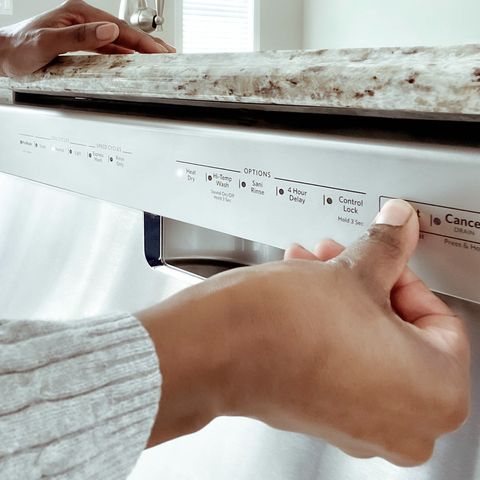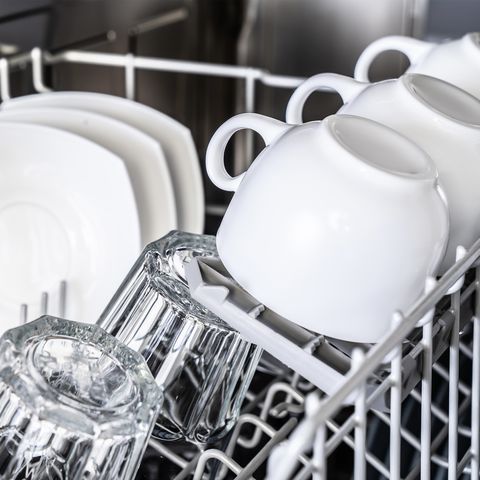Every Part, Piece, and Function of a Dishwasher You Should Know About

[ad_1]
There’s no question about it: Your dishwasher is one of the hardest-working appliances in your home. And anyone who’s lived without one knows what a true convenience it is to have a machine and some detergent do all that washing and scrubbing for you.
But no matter how advanced your model is, it requires proper usage and a little TLC to keep on keeping on—like monthly cleaning with an effective, deep-cleaning dishwasher cleaner, like Finish®.
Here’s what you need to know to help keep your beloved dishwasher in tip-top shape.
How A Dishwasher Works
Knowing how your machine works can help you take better care of it. So, let’s take a step back and get down to basics.
- Wash: Once your dishwasher is loaded, the door is closed, and you’ve selected your setting, the real magic happens. Your dishwasher—connected to a hot water line—will, depending on the cycle, boost the temperature of the water that comes into the machine.
Then, water is pumped through the spray arms, where it sprays out against the dirty dishes, explains Lynn Redmile, Testing and Product Review Analyst in the Good Housekeeping Institute’s Cleaning Lab. The force of the water makes the spray arms rotate. “Much like a rotating garden sprinkler,” she adds. Dishwashers filter and recirculate water many times throughout a cycle, and some even add more water and time depending on how dirty the load is. The dirty water then drains out through the pipes below your sink. Every load you do can add build-up to your machine’s hidden parts, so to help ensure it continues to run efficiently, you’ll want to do monthly cleanings with a solution like Finish Dishwasher Cleaner.
- Rinse: In this cycle, new water is pumped into the machine and pushed through those spray arms to rinse dishes of any remaining residue or detergent. It’s also when a rinse aid, like Finish Jet Dry, is dispensed to help prevent spotting and filming, as well as assist the drying cycle. Jet Dry uses surfactants to do its job—they reduce the surface tension of water and prevent droplets forming on dishes, which ultimately helps to banish water spots. If a sanitizing cycle is selected, the temperature of the final rinse is increased.
- Dry: This is the last step. Dishwasher users can opt to save energy and let dishes air dry in the machine or choose a heated drying cycle where a heating element heats the air in the machine to help speed the drying process. Note: As dishwashers have become more energy efficient, adding rinse aid, like Finish Jet Dry, helps water sheet off dishes, and helps items dry clear with fewer spots and less film. It also helps stop the redeposit of any food and detergent bits in the rinse portion of the cycle (since water is often recirculated within a cycle). But if the filter is clean, there shouldn’t be much of either in the rinse water, says Carolyn Forte, Director of Good Housekeeping Institute’s Home Appliances and Cleaning Products Lab.
What Parts Really Matter
If you really want to get into the nitty-gritty of it all, there are a few parts of a dishwasher you should know about.
- Spray arms: The spray arms are located at the bottom and in the middle, and sometimes at the top, too. As the machine runs, they rotate and blast water throughout the machine to clean dishes.
- Dispenser: Typically located on the inside of the door, the dispenser usually has two different compartments—one for detergent and one for a rinse aid. Throughout the cycle, timers ensure each solution is dispensed at the appropriate time.
- Filter: Every dishwasher has a filter and it’s a good idea to check it from time to time. Some are removable and can be cleaned with warm water.
- Heating element: This is the coil, typically found on the bottom of the machine, that heats the water for washing and the air for drying. (But some machines use condensation or evaporative drying.)
In terms of setup, most dishwashers have two pull-out racks, though some have a third, which is usually a dedicated tray/rack for cutlery and smaller items. “Generally, the more you pay for a dishwasher, the more options you have,” Redmile explains. This includes extras like specialty utensil baskets, stemware holders, and extra powerful jets for cleaning cookware.
Additional dollars also buys other features, like top-mounted controls for sleek design, digital displays, and dedicated programs like a sanitizing cycle, top- and bottom-only wash cycles and speed wash.
How to Keep Yours Running Smoothly
“With regular use, you can expect grease and grime to build up in the filter, spray arms, and the hoses of your dishwasher,” says Redmile. “In areas with especially hard water, you may also notice an abundance of limescale build-up.”
All of this gunk can affect the function of your appliance, she notes, and may result in dishes not being cleaned properly.
To help prevent this from happening, monthly cleanings are important, says Redmile. Use a dishwasher cleaner, like Finish Dishwasher Cleaner, approximately once per month—especially if you use your dishwasher frequently. During the cycle, this simple solution helps remove built up grease and limescale from areas like the filters, spray arms, and pipes, as well as other hidden parts inside.
This content is created and maintained by a third party, and imported onto this page to help users provide their email addresses. You may be able to find more information about this and similar content at piano.io
[ad_2]
Source link








